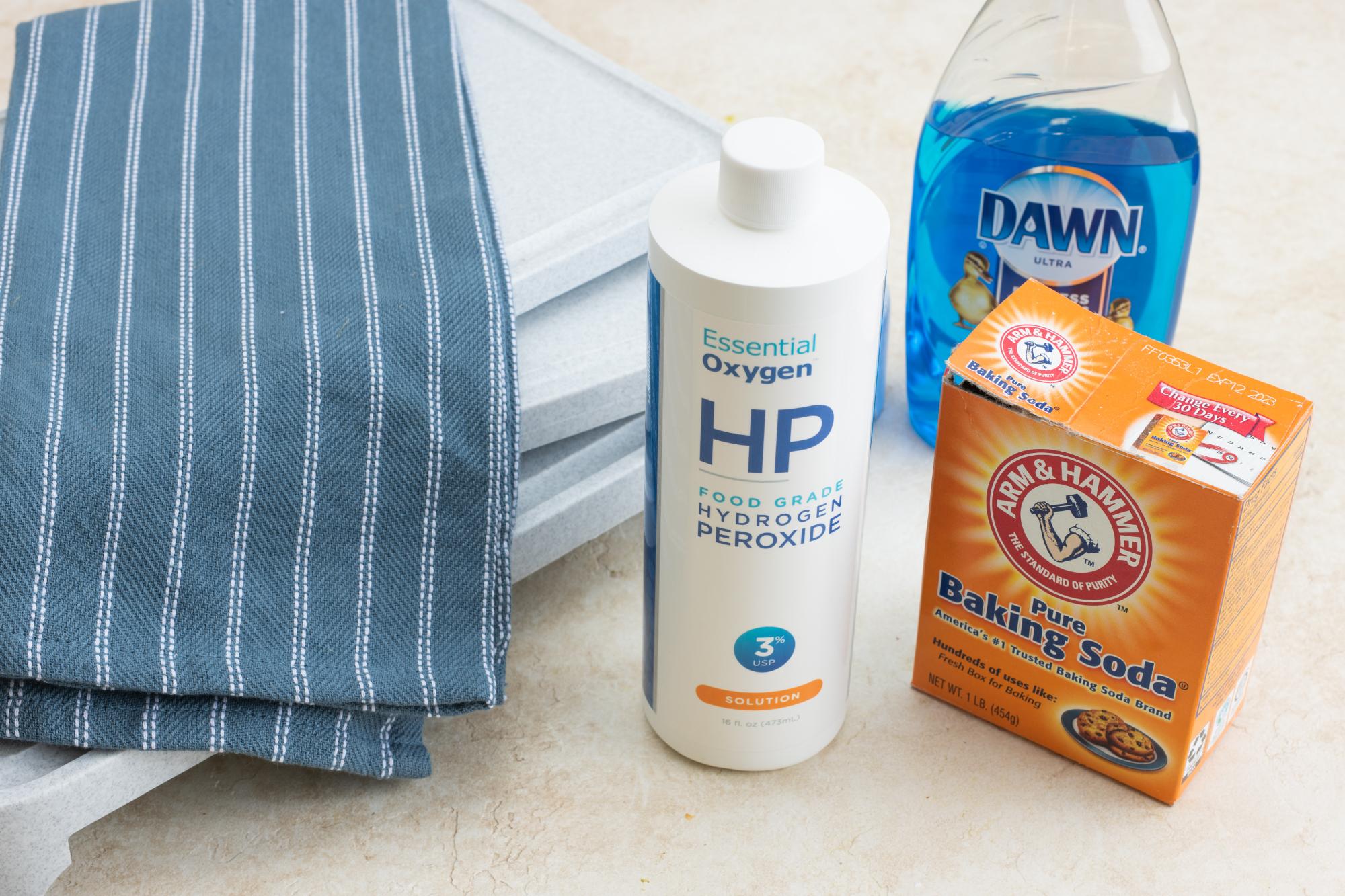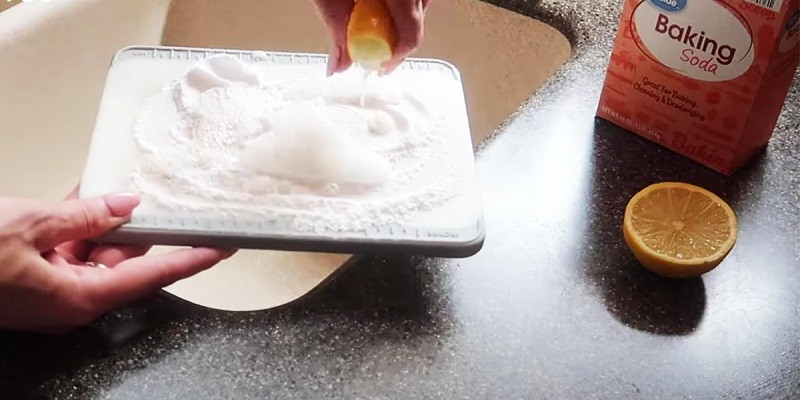To clean a plastic cutting board, scrub it thoroughly using hot, soapy water and a brush, then rinse it off with clean water. A plastic cutting board is a staple in most kitchens, but keeping it clean and free from bacteria is crucial for food safety.
By following a few simple steps, you can ensure that your plastic cutting board remains in excellent condition and safe for use. First, start by washing the board in hot, soapy water, using a brush to scrub away any debris or stains.
Rinse the board off with clean water and dry it completely before storing or using it again. Regular cleaning of your plastic cutting board will help prevent cross-contamination and keep your kitchen a safe and hygienic space for food preparation.

Credit: www.cutco.com
Selection Of Materials
Plastic cutting boards can be effectively cleaned by using a variety of materials such as vinegar, baking soda, or hydrogen peroxide. These options are safe, eco-friendly, and help to remove stains and odors from the surface, ensuring a hygienic food preparation area.
Plastic cutting boards are a common kitchen essential that requires regular cleaning and maintenance to ensure food safety. When it comes to cleaning your plastic cutting board, it is crucial to select the right materials that effectively remove bacteria and stains without causing any damage.
In this section, we will discuss the importance of using the right cleaning products and avoiding harsh chemicals for cleaning your plastic cutting board.
Using The Right Cleaning Products:
- Mild dish soap: Opt for a mild dish soap to clean your plastic cutting board. Mix a few drops of the soap with warm water in a sink or basin.
- Bleach solution: Prepare a bleach solution by combining 1 tablespoon of unscented chlorine bleach with 1 gallon of water. This solution helps sanitize the cutting board.
- Hydrogen peroxide: Hydrogen peroxide is an effective natural cleaner for plastic cutting boards. Create a solution of equal parts hydrogen peroxide and water and apply it to the surface of the cutting board.
Avoiding Harsh Chemicals:
- Ammonia: Avoid using cleaning products that contain ammonia, as it can damage the plastic material of the cutting board.
- Abrasive cleaners: Stay away from abrasive cleaners, such as scouring pads or powders, as they can scratch the surface of the plastic cutting board, making it more prone to bacterial growth.
- Harsh chemicals: Harsh chemicals like bleach or ammonia-based cleaners can deteriorate the quality of the plastic and leave behind toxic residues that can contaminate food.
Remember to rinse the cutting board thoroughly with hot water after cleaning and pat it dry with a clean towel. By using the right cleaning products and avoiding harsh chemicals, you can keep your plastic cutting board clean, safe, and ready to use for your culinary endeavors.
Preparing The Cutting Board For Cleaning
To clean a plastic cutting board, start by washing it with hot, soapy water. Then, rinse it thoroughly and let it air dry or pat it dry with a clean towel. Finally, sanitize the board by using a mixture of 1 tablespoon of bleach to 1 gallon of water, and let it sit for a few minutes before rinsing again.
Keep your cutting board clean to ensure safe food preparation.
To ensure that your plastic cutting board is thoroughly cleaned, it’s important to take the necessary steps to prepare it beforehand. This will help to remove any food particles and sanitize the board effectively. Follow the steps below for a clean and hygienic cutting board:
Removing Food Particles:
- Rinse the plastic cutting board with warm water to remove any loose debris.
- Use a dishcloth or sponge to scrub the surface of the board, focusing on areas with visible food particles.
- For stubborn stains or residue, create a paste using baking soda and water. Apply the paste to the stained areas and scrub gently with a sponge or brush.
- Rinse the cutting board thoroughly with warm water to remove all traces of food particles and baking soda paste.
- Pat the board dry with a clean towel or allow it to air dry completely before proceeding to the sanitization step.
Sanitizing The Cutting Board:
- Prepare a solution of one part bleach to four parts water in a sink or basin that is large enough to submerge the cutting board.
- Place the plastic cutting board in the bleach solution, ensuring that it is fully immersed.
- Let the cutting board soak in the bleach solution for at least 10 minutes.
- Remove the board from the bleach solution and rinse it thoroughly with warm water to remove any remaining bleach.
- Allow the cutting board to air dry completely before using it again.
By following these steps to prepare your plastic cutting board for cleaning, you can ensure that it is free from food particles and effectively sanitized. This will help to maintain a clean and safe kitchen environment while prolonging the lifespan of your cutting board.
Remember to perform these cleaning steps regularly to prevent the buildup of bacteria and odors on the board.
Deep Cleaning And Maintenance
Plastic cutting boards require regular deep cleaning and maintenance to ensure optimal hygiene. To clean your plastic cutting board, scrub it with a mixture of hot water and dish soap, using a sponge or brush. Rinse it thoroughly and allow it to air dry before storing it in a clean, dry place.
This simple routine will help keep your plastic cutting board clean and free of bacteria.
Plastic cutting boards are a popular choice in many kitchens due to their durability and easy maintenance. However, over time, these boards can accumulate stains, odors, and bacteria from frequent use. Deep cleaning and proper maintenance are essential to keep your plastic cutting board in top condition and ensure food safety.
In this section, we will explore three effective methods for deep cleaning your plastic cutting board: vinegar and baking soda, lemon, and bleach.
Vinegar And Baking Soda Method:
- Start by rinsing the cutting board with hot water to remove any loose dirt or debris.
- Sprinkle baking soda generously over the surface of the cutting board.
- Take a clean sponge or cloth and dampen it with white vinegar.
- Scrub the cutting board thoroughly with the damp sponge or cloth, paying extra attention to any stubborn stains or odors.
- Rinse the cutting board with hot water to remove any residue.
- Dry the cutting board completely before storing it to prevent mold or mildew growth.
Lemon Method:
- Squeeze the juice of a fresh lemon onto the surface of the cutting board.
- Use a clean sponge or cloth to spread the lemon juice evenly across the cutting board.
- Let the lemon juice sit on the board for a few minutes to allow its natural acidity to break down stains and eliminate odors.
- Scrub the cutting board gently with the sponge or cloth to remove any remaining stains or residue.
- Rinse the cutting board thoroughly with hot water.
- Dry the cutting board completely before storing it to prevent moisture buildup.
Bleach Method:
- Prepare a solution of 1 tablespoon of bleach per gallon of water.
- Immerse the cutting board in the bleach solution, ensuring that all surfaces are fully submerged.
- Allow the cutting board to soak in the solution for 5 minutes to effectively disinfect it.
- Scrub the cutting board with a clean sponge or brush to remove any remaining stains or residue.
- Rinse the cutting board thoroughly with hot water to remove any traces of bleach.
- Dry the cutting board completely before storing it.
Regular maintenance is also crucial for the longevity of your plastic cutting board. Here are some tips to keep it in great shape:
- Clean your cutting board immediately after each use to prevent stains and odors from setting in.
- Avoid using abrasive cleaners or scrub brushes that can damage the surface of the cutting board.
- Always store your cutting board in a dry place to prevent mold or mildew growth.
- Periodically sanitize your plastic cutting board by using any of the deep cleaning methods mentioned above.
- Consider using separate cutting boards for different types of foods (raw meat, vegetables, etc.) To prevent cross-contamination.
By regularly deep cleaning and maintaining your plastic cutting board, you can ensure a hygienic and safe food preparation surface for years to come. So, choose the method that suits you best and enjoy a sparkling clean cutting board that is ready for all of your culinary adventures.
Frequently Asked Questions On How To Clean Plastic Cutting Board?
What Can I Use To Clean Plastic Cutting Boards?
To clean plastic cutting boards, use a mixture of warm water and dish soap.
How Do You Sanitize A Plastic Cutting Board?
To sanitize a plastic cutting board, scrub it with hot, soapy water and rinse thoroughly. Then, use a mixture of bleach and water to disinfect it. Air dry completely before using again.
How Do I Make My Plastic Cutting Board White Again?
To make your plastic cutting board white again, try these simple steps: – Scrub the board with a mixture of baking soda and water. – Rinse thoroughly with warm water. – If stains persist, apply a paste of hydrogen peroxide and baking soda.
– Let it sit for a few minutes, then rinse and dry.
How Do You Clean A Plastic Cutting Board After Raw Chicken?
To clean a plastic cutting board after raw chicken: Scrub it with hot, soapy water, rinse thoroughly, then disinfect with a mixture of one tablespoon bleach per gallon of water.
How Do You Clean A Plastic Cutting Board?
To clean a plastic cutting board, wash it with hot, soapy water, and scrub it with a brush. You can also sanitize it by using a mixture of bleach and water.
Conclusion
Cleaning your plastic cutting board is essential to maintain proper hygiene in your kitchen. By following a few simple steps, you can ensure that your cutting board remains clean and safe to use. Start by scraping off any food particles using a spatula or scraper.
Next, wash the board with hot soapy water, making sure to scrub thoroughly using a dishcloth or sponge. For a deeper clean, create a solution using equal parts water and white vinegar, and wipe down the board using a cloth soaked in the mixture.
To remove stubborn stains and odors, sprinkle baking soda on the board and scrub gently. Finally, rinse the board with hot water and pat it dry with a clean towel or let it air dry. Remember, maintaining a clean cutting board is crucial to prevent cross-contamination and ensure the safety of your food preparation.
Editorial Recommendations:
- Why Is It Necessary To Clean Vent Hood Filters?
- How To Clean An Industrial Piercing?
- Can I Use Contact Solution To Clean My Piercing?
Last Updated on October 19, 2025 by Marjorie R. Rogers, MA (English), Certified Consultant




